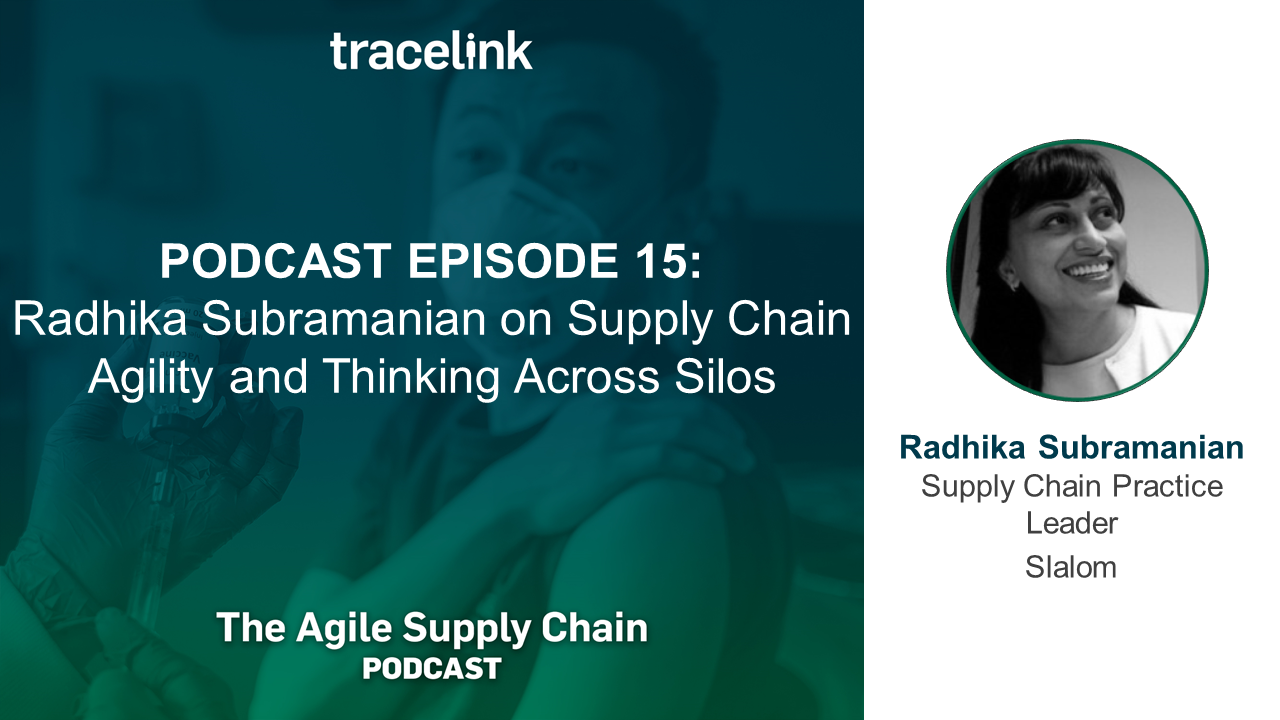Table of contents
Key Takeaways
- Many supply chain executives say end-to-end visibility is the number one requirement for a smart and responsive supply chain.
-
To become more agile, you first need to bring your organization’s division leaders together and get them adopt a cross-silo mentality.
-
You can use technology that exists today to augment legacy systems and create an agile, responsive, and intelligent supply chain.

How can analytics and cross-silo thinking help you achieve agility and resiliency in your supply chain organization? In this episode of The Agile Supply Chain Podcast, Radhika Subramanian, Supply Chain Practice Leader at Slalom, a business and technology consulting firm, offers a step-by-step path to agility. She also explains why you don’t necessarily need to rip and replace your legacy systems to get there.
Transcript:
Radhika Subramanian, Supply Chain Practice Leader at Slalom, a business and technology consulting firm, offers a step-by-step path to supply chain agility, right now on The Agile Supply Chain Podcast.
Roddy Martin: Radhika, welcome to this thought leadership series that TraceLink is sponsoring. It's obviously very exciting to have supply chain thought leaders, industry thought leaders like yourself, talking about your experiences, your insights.
In particular, one of the pieces on the table that we've teed up is this technology and vendor agnostic Agile Supply Chain Credo, which we're going to touch on. It gives us a great agenda, and especially in your domain of, "Where could analytics take us?" That is the hidden gem that I think we're going to see in the next couple of years.
Welcome. It's a pleasure to have you from Slalom. I love your perspectives from the discussions we've had, so over to you to introduce yourself.
Radhika Subramanian: Well, Roddy, thank you so much. First and foremost, thank you so much for inviting me to participate in this webinar. I'm absolutely delighted.
My name is Radhika Subramanian. I am the supply chain practice leader for Slalom. Slalom is a global consulting firm, and we've got an amazing partnership with companies like AWS. We're, in fact, a premium partner.
My background, I have been working on supply chain and data‑driven supply chain capabilities for a fairly long time. I was very fortunate in actually having the opportunity to work with one of our clients in building what's called a demand‑driven supply chain. It was such a fantastic success that Gartner wrote a white paper on it.
Now what I'm doing at Slalom is working with our partners and our clients to enable what's called a smart supply chain or an agile supply chain, which is absolutely a need and necessity today.
Roddy: That's fantastic. Given the agile credo, what really pops out? There's hundreds of things that you can derive out of the credo. What really pops out at you when you look at that credo?
Radhika: You know, the word “agile” is so overused. What does agile really mean? When I think about agile, I think about sports terminology. It's a “full‑body” response. For example, if I pinched you on your toe, it takes your entire body to respond to that kind of a thing.
Agility is the ability of an organism, an organization, a body, to actually have a full‑body response to something. For me, the supply chain agility means that the organization end to end has been able to connect the pieces so that they can seamlessly respond, no matter which part of the organization they're in.
Roddy: I absolutely love that simple, very illustrative definition of whole‑body response. It makes me think of that healthcare picture you see ‑‑ I think it comes from Greek mythology ‑‑ of the human body stretched out in a circle, and everything is connected. To improve something, you've got to improve everything.
I think that analytics is such an untapped opportunity. When you think about this whole‑body response, what jumps out at you as the big opportunity for analytics? I think things change, right?
Radhika: Right.
Roddy: Many companies have spent billions of dollars putting in transactional reporting systems.
Radhika: Yeah.
Roddy: That's not what the future's about. What is the future about?
Radhika: That's a really good question, Roddy. You're right. Companies have spent decades trying to put together enterprise applications and supply chain systems. As we have gotten better and better at these applications, unfortunately, we have gotten more and more siloed, and more and more specialized.
What that's rendered is literally the fact that we are very good at very small pieces of it. We have started to specialize applications that are very good at pieces of it, but we've really not focused too well on thinking about this as an end‑to‑end capability.
Over 80 percent of supply chain execs have said that end‑to‑end visibility is probably their number one requirement for a smart supply chain response. If you don't know what's happening across the organization, you really can't respond in an intelligent way.
Roddy: I love that perspective, and it's a question or a perspective that jumps out at me. One of my coaches, mentors in my career said to me, “Roddy, never, ever say it's a leadership problem because I don't know what that means.” Leaders don't know what that means.
I will say that one of my concerns and observations is that supply chain and function leaders don't necessarily know how to think about the huge opportunities in analytics. How do you address it? Because your challenge is you knock on the door, and you say, "I'm here to help you with analytics." They're going to give you what's front of mind.
What is the problem that I tactically have today? I have a quality orders, contract manufacturing order, an inventory, blah, blah, blah. How do you take their mindset into the whole‑body experience scenario without making it look like and sound like the world's problems?
Radhika: That's a good question. Technologists are guilty of thinking in terms of technology. We think in terms of analytics or data, but no customer ever says, give me analytics or give me a pound of analytics. It doesn't. How do you buy analytics? I don't know.
Nobody says, "Hey, I want some analytics." If they do, Roddy, that means they haven't understood their problem, which is a whole other problem. Business leaders typically come to us to say, here are the issues I'm struggling with. I'm struggling with too much inventory. I'm struggling with very long lead times for my customers. I'm struggling with...the order is never right the first time.
The entire journey of analytics begins with a business problem. Once you understand the business problem, then you'll start peeling the onion back to say, "You have long customer lead times, I wonder why that is."
Let's look at where the orders are coming from, where your parts are coming from, how you fulfill them. Then you use a combination of people, process, technology, data to respond to it. Any one of those KPIs that you have ends up becoming an end‑to‑end solution. You literally don't have to force it.
Roddy: That illustrates the whole‑body experience. One of the responses you can get to the problem is, "Man, I've got so many problems, I don't know where to start. I've got an inventory problem. I've got a teamwork problem. My contract manufacturers are not delivering quality, etc."
You said yourself, "Oh my gosh, where do I start with this person?" One of the suggestions I make and I'd love to hear your responses, let's start with the 20 percent of your issues that you're discovering that prevent you from being agile and responsive to any demand changes or any disruptions in the marketplace.
Let's think about the 20 percent that cause 80 percent of the issues, is that an approach that works for you and is there anything that jumps out in the credo that helps you along those lines?
Radhika: Yeah, absolutely. The idea of having to create an end‑to‑end total solution is extremely daunting. When we look at supply chain leaders today, when we look at companies that have done a good job at customer response and at being resilient, this wasn't done in one day. This is a slow and continuous process.
How do you do that? The way you do that is, you do an evaluation of where are we today. Where are the gaps and the cracks? What are we not doing well? Where could we fill in to make this more responsive?
Then over a period of time, you start laying and augmenting your capabilities with the kind of solutions you need. That's where partners like AWS come in with an amazing set of capabilities. You can augment on top of your legacy systems the kind of capabilities, analytics, and data responses that give you the speed to be able to respond.
This is my long‑winded answer. It isn't done in one day. It's done as a continuous process, Roddy.
Roddy: Radhika, you've identified some really good starts, like go out and understand the end‑to‑end process and figure out what are those issues that are causing you pain. What do you think leaders companies need to stop doing? Because, often, the start is great, but the stops really get in the way. They fizzle out their energy.
Radhika: Roddy, the most critical stop is siloed thinking. When you look at leaders today, they have over decades built out specializations in very specific areas. But, when you look at customers and how customers are coming to us and how they are buying, they're coming almost channel‑agnostic.
They may come through a mobile phone. They may come through social media. They may come through a website. They may walk into a store. The order fulfillment is also channel‑agnostic. They may say, "I'll pick it up in a car," or, "Deliver it," or, "I'll pick it up from a shipment center or your store," or to use a different address.
I think that the promise of digital supply chain is that I will give you the product or the service at the right place at the right time with the highest level of service. To be able to do that, you have to start thinking of the organization as a seamless end‑to‑end continuity, so that you can look at the available supply end‑to‑end and start to look at what the demand is so you can respond to it really well.
My one single thing would be the siloed thinking, really that's a big stop. We have to stop that.
Roddy: I have a great story to tell, and it's very public‑domain, that is, the CEO of Procter & Gamble, who coined the expression, "The first moment of truth is the product’s available when the customer/patient wants or needs it."
I can remember I was in the room when he said, "I don't care that manufacturing shipped it on time. If it wasn't on the shelf, you all failed as a system." That's the whole‑body experience. Don't tell me logistics did it right, manufacturing did it right, but customer service and account management did it wrong, because you all failed, in my opinion.
I think that's a good indication. One of the things that I'm seeing more and more, and I love to track what the publications and the media and social media are pushing out, and there's a flurry of AI and machine learning.
What would your comment be about the pragmatic introduction of very sophisticated capabilities like machine learning and artificial intelligence into supply chains?
Radhika: I'll go back to the comment I made earlier that technologists are guilty about thinking about technologies in silos. Also, I think the second part is the lack of connectivity to the business problem itself.
Because of that, Roddy, and you're aware of this, we see so many POCs with amazing technologies. Every company has them. It's almost like a graveyard of POCs. The way to get away from that is for these technologies to connect with the business problem.
If you think about AI or ML not as AI or ML but to turn around to say, "What is the supply chain problem that I have? I have orders that are getting delayed. How could I solve that?
"Well, let me look at the transactional orders. There is a pattern of delays over here. Let me use technology like ML or machine learning to learn from the patterns of delays and start to predict it.
"When it comes from Savannah, with this certain distributor or this 3PL out of this warehouse with these parts, there's an 85 percent chance of delay. Let me bubble those to the top and proactively tap a person on the shoulder when we see it again."
This is my long‑winded way of saying that it's the responsibility of technologists to work with the business users, understand the problems that they have, and connect it back and say, "You know, we can solve that problem with this combination of technologies," because, at the end of the day, in my opinion, the business leader doesn't care so much about the technology but they really do care that you have solved their problem.
Roddy: It wasn't a long‑winded answer at all. I think it was an excellent example of what, in fact, we are living in the end‑to‑end healthcare system, because you have a very complex supply chain downstream, you have distributors, wholesalers, retail pharmacies, clinics, hospitals, etc.
It's very complicated. Unless you can bring all the data together and start looking for the insights, if you look at those things functionally, you're not going to see the interactions between, "OK. It's really weird. This happened in the retail channel, but it's also happening in the clinics channel. Is there a common denominator?"
I think it was an excellent example of how you trace the problem and I think it illustrates an important point. On time in full at the point at which it really counts, all the way back into the supply system and go and find and then model and use these advanced technologies to flesh out and identify the new questions that we should be asking.
"Is it always this wholesaler, this warehouse, this 3PL?" I think it's a great example, and I think the healthcare system lives that all of the time.
Radhika, this has been really great. Obviously, we can't solve the analytics and supply chain challenge in one word, but I recently did a podcast on the use of platforms like AWS in supply chain. I'm blown away by the response I got to it, because I think people, leaders, businesses are generally realizing that ERP wasn't a bad move.
It was necessary, but it's not sufficient. I think part and parcel of that "not sufficient" is the analytics that the ERP vendors have given us are just not well enough established in the outside-in, end‑to‑end supply chain.
What nuggets of recommendation, if you were sitting in front of a CEO of a $60‑billion global pharmaceutical healthcare company and you said, "You know what? I'm going to leave you with a Radhika nugget of wisdom. Just go and chew on this and see where it takes you." What would that be?
Radhika: It's a really excellent question. You know, Roddy, it's very, very easy to quickly blame the old and think that the new is wonderful. We are in a time of continuous change. What companies have done over the last few decades is invested in applications that do a certain set of processes really well. That was required at the time. Given the speed at which business moved, it worked.
The speed of business is just going faster and faster, and the volatility is increasing dramatically, which brings us to agility. Why do we need agility? We need agility because of this volatility. We need to be able to respond to this volatility.
Siloed systems, no matter how good your analytics is on a single warehouse management system on a single finance system, it doesn't help you to respond to the volatility really well. My one piece of advice to any CEO would be, get your leadership together. Let them start thinking about the interaction between their divisions.
How does the distribution center really contribute to the inventory? How does the product person think about the product mix? How does the e‑commerce person look at the orders and the demand that's coming in? Where are they pulling the fulfillment from?
In that cross‑silo thinking based on the business problems that they're trying to address, through that will emerge the need for a hub.
If we get this data from our ERP system and this demand coming from the e‑commerce and we put it together, we will be able to see how to fulfill this better, which brings me to the need and the fantastic solution of augmented analytics on top of legacy systems.
What this augmentation does is it says, we don't have to invest in integration because that's expensive. Let's start augmenting the data in overlay as an overpass so that now we have cross‑silo visibility. And where leaders like AWS become important is you now, by migrating that to a cloud, you have such resilience and broad access to systems like that.
My one piece of advice would be to bring your leaders together, and start thinking cross‑silo.
Roddy: That's a fantastic piece of advice. If I can add into that, almost a piece of his history where CEO of P&G says, "Look, when I make a promise to a shopper that it's going to be on the shelf, it will be on the shelf."
Let's look at everything that leads to that shelf. Public domain, if you go and look at Novo Nordisk's Annual Report, you'll see they talk about the CEO wants the right diabetic equipment right in the hands of every single patient.
Well, if it's in the hands of the patient, it means it has to go through all the stages of the supply chain, from the initial production of delivery systems and insulin, all the way to the patient in a hospital. If you think about that in silos, it makes it extremely difficult because integration just becomes the showstopper, let alone the visibility of all the data.
It's an excellent point of view. I think that more and more CEOs, in my opinion, are starting to realize that the supply chain model, the end‑to‑end value network, whatever you want to call it, is, in fact, the business operating model.
It's not just a product supply‑driven network that produces hundreds of days of inventory and hopes like crazy that it's going to be at the right place at the right time.
In closing, Radhika, and it's been a real privilege to talk to you. This is fleshed out some good high‑level point of view, as was the intention in the agile credo.
We all know, you know as well as I do, people are going to listen to this and say, "Yeah, this credo is great, but it doesn't tell me what I need to do differently tomorrow." What would your nugget be?
Radhika: That's a good question. I don't think it's just one nugget, it's a sequence of nuggets.
The first nugget would be the technology and capabilities exist today to overlay legacy systems and create agile or smart responsive system. That's the first one.
The second, which is almost a little contradictory or contrary is that, technology and data is not the only answer. The most agile, the most responsive are your people. It's a combination of people and technology.
How does that come together? The way it comes together is machines do a great job of automating repetitive tasks, so we should leverage that. Automate as much as we can, just isolate the exceptions and that's where human intelligence is so valuable.
It would be so great for a human to wake up or just be nudged on the shoulder to say, these are the only five orders you need to look at. Don't worry about the others, they've been taken care of. That combination of computing power, man and machine is a great solution.
The last piece is the job's never done. The world keeps changing, so this needs to be a continuous cycle of as we learn more, we say, "We know how to do this, let's automate this part of it."
Here are the exceptions. Human intelligence should be used to manage the exceptions, make sure things are going on track, and we should just accelerate automation to do what's repetitive. That's a blend of both worlds.
Roddy: Very pragmatic and you've left me with a nugget. That is, you will hear me use again and you will see it in my writing this whole‑body experience, because that's probably such a simple thought, and yet, it's a profound thought.
It's a profound challenge for a lot of organizations is, for the whole business to behave as one body. It's not about just your feet or your hands. If your feet are broken, you can't walk. If your hands are broken, there's other things you can't do.
It's been a great privilege to have you. We certainly look forward to working with you in the future. This has been fun. It's been a very stimulating discussion. Thank you very much, I appreciate your time.
Radhika: Roddy, thank you so very much. You're right, agility is about fitness. I have so enjoyed talking to you. Thank you so very much and have a fantastic day.
Roddy: You too, Radhika. Thank you.
Return to: The Patient-Driven Supply Network






